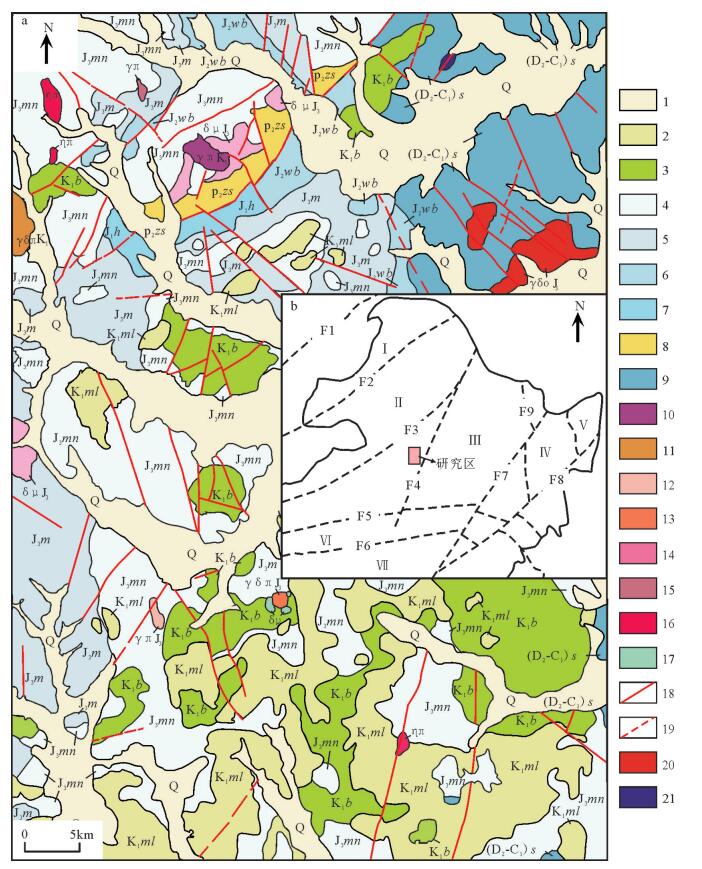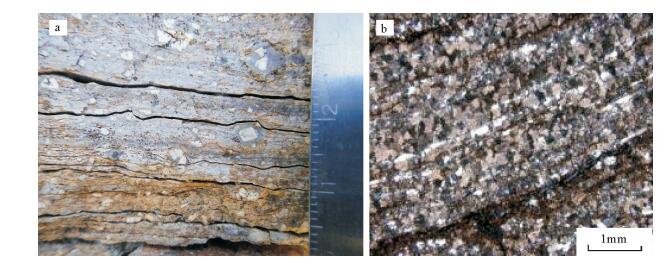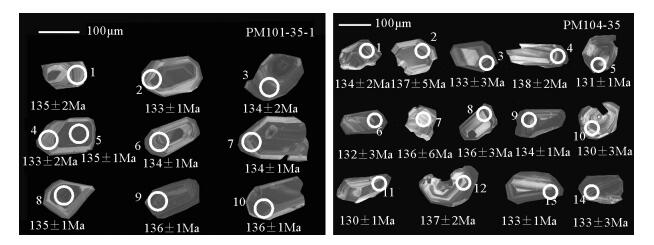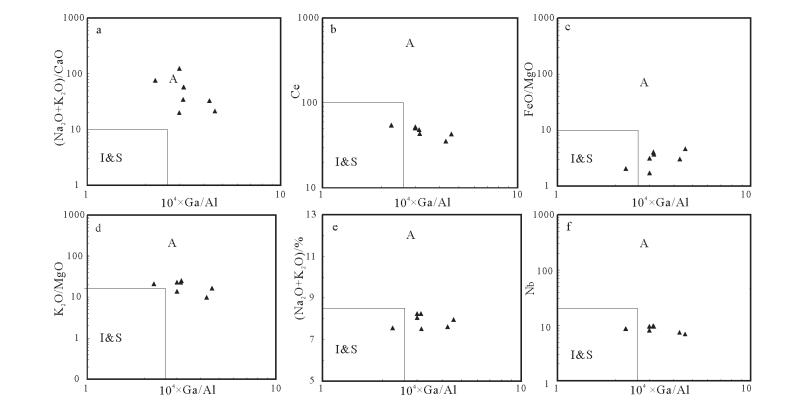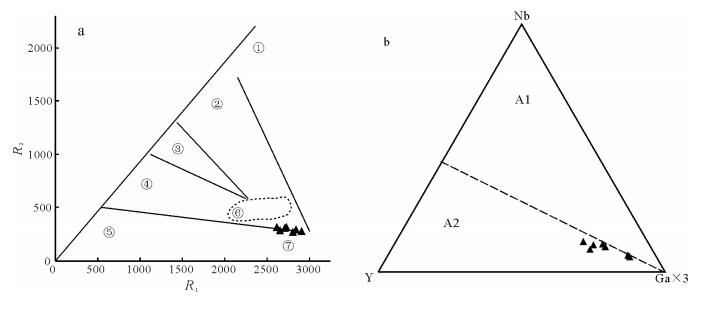Zircon U-Pb dating and petrogenesis of Early Cretaceous alkaline rhyolites in Tuquan Basin of middle Da Hinggan Mountains
-
摘要:
LA-ICP-MS锆石U-Pb年龄表明,突泉地区碱性流纹岩锆石的206Pb/238U年龄分别为135±1Ma、133±1Ma,属于早白垩世岩浆活动的产物。岩石地球化学资料表明,碱性流纹岩具富SiO2、K2O和高TFeO/MgO值,低Al2O3、CaO和MgO的特征,属于高钾钙碱性系列岩石,稀土元素总量较高,轻、重稀土元素分馏明显,具右倾的稀土元素分布模式,负Eu异常明显,相对富集Rb、U、Zr、Hf,亏损Sr、Ti、Nb、Ta等元素,花岗岩判别图解上,样品分布在A型花岗岩区;在Nb-Y-3Ga图解上,显示拉张构造环境的A2型花岗岩的特征;元素地球化学示踪指出,突泉地区碱性流纹岩可能起源于下地壳的部分熔融,结合区域上分布的同时代火山岩及A型花岗岩类,可以限定碱性流纹岩形成于伸展构造背景,并可能与北部蒙古-鄂霍茨克缝合带的演化有关。锆石Hf同位素研究显示,本区早白垩世流纹岩εHf(t)值为+4.2~+10.7,其二阶模式年龄平均为0.74~0.76Ga,结合松嫩地块、兴安地块Hf同位素资料,表明兴安地块与松嫩地块具有相似的地壳增生过程。
Abstract:The LA-ICP-MS zircon 206Pb/238U age estimates for the alkeline rhyolites yielded weighted average ages of 135±1Ma and 133±1Ma, indicating Early Cretaceous. The whole-rock geochemistry of the alkeline rhyolites shows an A-type magmatic affinity, with a typical enrichment of SiO2, K2O and a high ratio of TFeO/MgO, and low content of Al2O3, CaO and MgO, belonging to Khigh calc-alkaline series rocks; high ∑REE and fractionated REE patterns show strong negative Eu anomalies, relative enrichment of Rb, U, Zr, Hf, but depletion of Sr, Ti, Nb, Ta. In the discrimination diagrams of granites, all of the samples show the characteristics of A-type granites; in the Nb-Y-3Ga diagram, the samples show the characteristics of A2-type granites. These elements show that the alkeline rhyolites were derived from partial melting of crust materials. Viewed from regional correlations with the volcanic rocks as well as A-type granites, it is held that the alkeline rhyolites were associated with an extensional tectonic setting, being the product of a regional extensional environment associated with the evolution of Mongol-Khotsk suture. Zircon Hf isotope analyses show that dacite of Cretaceous have εHf(t) values of +4.2~+10.7 with Hf modal ages being 0.74~0.76Ga, indicating that there existed similar crustal processes between Xing'an block and Songnen block.
-
Keywords:
- Tuquan area /
- alkeline rhyolites /
- Early Cretaceous /
- zircon U-Pb age
-
煤中稀土元素的研究一直是煤地球化学领域研究的热点问题,一方面是因为煤中稀土元素具有均一化程度高、化学性质稳定、不易受变质作用影响等特殊的地球化学特征,其赋存状态、分配模式可以指示成煤环境、追踪对比煤层[1-5];另一方面是稀土元素含量较高的煤层,煤灰中富集的稀土元素达到了工业利用价值[6],提高了煤炭综合清洁利用水平,如俄罗斯远东和中国西南晚二叠世煤中稀土元素富集,煤灰中稀土元素含量可以达到工业利用标准[7]。
20世纪90年代开始,中国学者开始对煤中稀土元素的含量及地球化学特征进行研究[8-11]。对不同成煤时代及不同成煤环境煤中稀土元素的分布模式、成因、赋存状态等进行了详细研究,研究区域涉及华北、淮南、淮北、西南等各大煤田[12-14]。相对于其他国家和地区煤中稀土元素的含量,中国煤中稀土元素的含量变化范围更大,含量更高。根据煤中稀土元素含量的差异,可以重塑成煤环境演化史;根据稀土元素标准化曲线能判断母岩的类型、来源等重要信息;重稀土和轻稀土元素的分馏机制与煤的形成环境紧密关联,可以分析煤炭沉积史。聚乎更矿区是青海省木里煤田重要的大型煤矿区之一,煤炭资源储量丰富。目前主要针对聚乎更矿区的地层构造、煤岩煤质及沉积环境开展了诸多研究并取得了一些成果[15-17];然而关于成煤环境研究较少,煤中微量元素的研究基本未开展。本文对聚乎更矿区煤中稀土元素的地球化学特征进行初步分析,从煤地球化学角度探讨煤层沉积环境和物源特征,为煤炭资源清洁利用提供基础理论依据。
1. 地质背景
木里煤田位于中祁连坳陷带的中西部,总体走向为北西西—南东东向,经过多期构造演化形成中生代含煤盆地的构造形态[15]。聚乎更矿区位于青海省木里煤田中西段(图 1),构造线总体方向为北西向,整体构造形态为一复式向斜,向斜轴倾向北东∠50°~70°。矿区共划分为4个井田和3个露天矿。矿区含煤地层为中侏罗统木里组和江仓组,大部分地区中侏罗统不整合于三叠系之上,仅局部地区与下侏罗统整合接触。木里组下段为辫状河冲积平原环境,沉积了一套粗碎屑岩;上段以三角洲前缘-泻湖沼泽环境为主,发育主要可采煤层下1煤和下2煤(图 2)。下1煤全区可采,主要形成于三角洲前缘沉积环境,夹矸发育,岩性以泥岩、粉砂岩为主,受河流作用影响较大[18]。下1煤层厚度范围为0.68~39.95 m,平均厚度为11.55 m。下1煤形成时期沉积环境比较稳定,受后期构造变化的影响,煤层厚度由西向东逐渐变薄。江仓组下段主要为三角洲-湖泊沉积环境,含煤2~6层;上段以浅湖-半深湖环境为主,沉积了一套细碎屑泥岩、粉砂岩,不含煤。本次研究对象为木里组下1煤层。
2. 样品采集与测试
本次在聚乎更矿区一井田、三井田和四井田主采煤层下1煤共采集样品20件(图 1),其中煤样品14件,顶底板样品6件。采样时首先在剖面上按宏观煤岩类型自然分层,用记号笔标注分层位置和样品编号,自下而上逐层刻槽采样,每个样品重量约2 kg,样品采集后迅速装入已编号的采样袋中,以避免水分散失和污染。为更好地对比煤中稀土元素来源的影响,采集了顶底板泥岩样品。其中,一井田采集煤样12件,顶底板泥岩样品各1件;三井田采集煤炭组合样1件,顶底板样品各1件;四井田采集煤炭组合样1件,顶底板样品各1件。
样品采集后及时送至江苏地质矿产研究分析测试中心,依据煤的工业分析方法(GB/T212—2008)测试了聚乎更矿区下1煤的煤质数据;利用光学显微镜(DM2500P)获得了煤岩显微组分图像;采用X射线荧光光谱法(XRF)进行了样品主量元素K2O、Na2O、SiO2、Al2O3、Fe2O3、CaO、MgO、SO3、MnO2、P2O5和TiO2的定量分析;采用高分辨电感耦合等离子质谱(ICP-MS)进行了样品稀土元素质量分数的测试;利用全岩和粘土矿物X射线衍射(XRD)对煤层顶底板泥岩样品进行了矿物组分测试。
3. 结果和讨论
3.1 煤及顶底板泥岩中稀土元素含量
因Y的地球化学性质和稀土元素非常相似,而且其离子半径、离子电荷与Ho极相似,本文将Y置于Dy和Ho之间,与稀土元素一起讨论[6]。单从稀土元素总量看,其数值变化较大,聚乎更矿区下1煤中稀土元素(REE)含量为5.23×10-6~55.79×10-6,平均值23.01×10-6,该数值明显低于中国煤中的REE质量分数平均值(135.89×10-6)[19]和世界煤中的平均值(68.47×10-6)[20],表明聚乎更矿区下1煤中稀土元素含量总体不高,相对不富集(表 1)。下1煤层顶底板泥岩中稀土元素含量为99.96×10-6~265.68×10-6,平均值为198.62×10-6,可见泥岩中稀土元素总量远高于煤中,平均值为煤中的8.6倍,且相对富集轻稀土元素(LREE)(表 2;图 3)。Seredin等[6]研究发现,同一物源条件下,稀土元素在煤层顶底板细粒岩石中更易于富集。本次稀土元素测试结果与Dai等[21]在该区的研究结果一致,受陆源碎屑的输入影响,稀土元素在泥岩中更容易富集。
表 1 聚乎更矿区下1煤中稀土元素含量Table 1. The content of rare earth elements in the No.1 coal from Juhugeng coal district10-6 采样位置 样品编号 岩性 La Ce Pr Nd Sm Eu Gd Tb Dy Ho Er Tm Yb Lu Y 一井田 1J-1 顶板泥岩 43.5 81.7 8.72 33.3 6.42 1.28 5.51 0.88 4.83 1.00 2.77 0.46 3.03 0.48 27.1 1J-2 原煤 2.17 2.99 0.51 1.66 0.24 0.025 0.25 0.042 0.17 0.040 0.12 0.042 0.12 0.027 2.21 1J-3 原煤 1.46 3.20 0.54 1.72 0.28 0.070 0.26 0.055 0.30 0.070 0.21 0.043 0.26 0.046 2.04 1J-4 原煤 2.70 4.51 0.60 1.77 0.26 0.10 0.28 0.054 0.30 0.061 0.18 0.035 0.19 0.035 1.50 1J-5 原煤 1.77 2.13 0.59 1.61 0.23 0.16 0.23 0.052 0.20 0.045 0.13 0.033 0.14 0.036 1.41 1J-6 原煤 2.32 4.06 0.58 1.84 0.30 0.053 0.28 0.054 0.27 0.057 0.17 0.035 0.18 0.034 1.58 1J-7 原煤 2.08 3.46 0.56 1.80 0.29 0.086 0.27 0.049 0.22 0.080 0.14 0.032 0.16 0.033 1.24 1J-8 原煤 1.62 2.89 0.51 1.61 0.26 0.069 0.24 0.047 0.23 0.053 0.15 0.034 0.17 0.035 1.47 1J-9 原煤 4.00 6.89 0.85 3.04 0.53 0.12 0.48 0.089 0.53 0.12 0.36 0.066 0.45 0.076 3.49 1J-10 原煤 14.1 19.7 2.16 6.24 0.91 0.21 1.02 0.19 0.92 0.19 0.56 0.11 0.61 0.11 5.39 1J-11 原煤 8.66 15.8 1.82 6.73 1.33 0.25 1.19 0.19 1.13 0.23 0.65 0.10 0.69 0.14 6.46 1J-12 原煤 12.2 18.9 1.87 6.83 1.33 0.36 1.24 0.22 1.46 0.33 1.00 0.21 1.20 0.18 8.50 1J-13 原煤 7.68 14.0 1.52 6.07 1.25 0.24 1.10 0.18 1.04 0.20 0.54 0.08 0.51 0.08 5.72 1J-14 底板泥岩 34.2 68.3 7.26 26.4 4.55 0.76 3.99 0.61 3.13 0.59 1.61 0.28 1.69 0.29 16.1 三井田 3J-1 顶板泥岩 51.2 97.2 11.4 41.1 8.04 1.61 6.70 1.04 5.84 1.20 3.42 0.54 3.69 0.56 32.1 3J-2 原煤 0.69 1.10 0.43 0.95 0.17 0.019 0.17 0.04 0.17 0.04 0.12 0.03 0.17 0.03 1.11 3J-3 底板泥岩 51.7 96.1 10.9 38.5 7.80 1.50 6.59 1.05 6.12 1.24 3.46 0.55 3.74 0.56 35.3 四井田 4J-1 顶板泥岩 33.2 63.9 7.18 27.1 5.04 1.09 4.30 0.66 3.44 0.68 1.94 0.32 1.92 0.33 19.1 4J-2 原煤 2.48 2.67 2.09 2.85 0.27 0.012 0.41 0.10 0.04 0.02 0.07 0.09 0.15 0.07 1.38 4J-3 底板泥岩 17.9 31.3 4.35 15.4 2.91 0.84 2.74 0.53 3.17 0.63 1.66 0.29 1.63 0.29 16.4 表 2 聚乎更矿区下1煤中稀土元素地球化学参数Table 2. Geochemical parameters of rare earth elements in the No.1 coal from Juhugeng coal district采样位置 样品编号 Ad/% REE LREE HREE L/H (La/Yb)N (La/Sm)N (La/Lu)N (Gd/Lu)N δEu δCe 一井田 1J-1 / 220.9 174.9 46.05 3.8 9.67 4.26 9.42 1.43 0.66 1.01 1J-2 1.20 10.61 7.59 3.02 2.51 12.69 5.675 8.45 1.147 0.31 0.688 1J-3 6.71 10.56 7.27 3.29 2.21 3.78 3.306 3.31 0.704 0.80 0.866 1J-4 4.71 12.57 9.93 2.63 3.77 9.63 6.51 7.92 0.995 1.17 0.855 1J-5 25.41 8.78 6.50 2.28 2.85 8.44 4.76 5.12 0.801 2.09 0.500 1J-6 3.09 11.81 9.15 2.65 3.45 8.50 4.934 7.06 1.003 0.57 0.839 1J-7 2.33 10.50 8.28 2.22 3.72 8.52 4.555 6.63 1.009 0.96 0.550 1J-8 3.31 9.39 6.96 2.43 2.86 6.26 3.950 4.82 0.842 0.86 0.766 1J-9 6.52 21.10 15.43 5.67 2.72 6.00 4.73 5.50 0.797 0.75 0.90 1J-10 35.14 52.4 43.3 9.10 4.76 15.53 9.70 12.93 1.12 0.67 0.86 1J-11 9.70 45.35 34.6 10.77 3.21 8.44 4.10 6.65 1.09 0.62 0.96 1J-12 18.53 55.8 41.4 14.36 2.89 6.81 5.73 6.99 0.86 0.85 0.95 1J-13 5.77 40.23 30.8 9.45 3.26 10.25 3.87 10.19 1.74 0.63 0.99 1J-14 / 169.8 141.5 28.29 5.0 13.63 4.73 12.45 1.74 0.54 1.04 三井田 3J-1 / 265.7 210.6 55.1 3.8 9.36 4.00 9.46 1.48 0.67 0.97 3J-2 17.82 5.23 3.35 1.88 1.78 2.80 2.559 2.28 0.68 0.34 0.48 3J-3 / 265.1 206.5 58.6 3.5 9.33 4.17 9.53 1.45 0.64 0.97 四井田 4J-1 / 170.3 137.6 32.71 4.2 11.70 4.15 10.56 1.63 0.71 1.00 4J-2 4.45 12.70 10.37 2.33 4.46 10.99 5.771 3.84 0.76 0.11 0.28 4J-3 / 100.0 72.7 27.30 2.7 7.42 3.87 6.43 1.18 0.91 0.85 注:陨石数据采用Boynton推荐的球粒陨石平均值[25];∑LREE=La+Ce+Pr+Nd+Sm+Eu;∑HREE=Gd+Tb+Dy+Ho+Er+Tm+Yb+Lu;∑REE=∑LREE+∑HREE;(La/Yb)N、(La/Sm)N、(La/Lu)N、(Gd/Lu)N元素球粒陨石标准化值的比值;δEu=EuN/(SmN×GdN)1/2,δCe=CeN/(LaN×PrN)1/2,EuN、SmN、GdN、CeN、LaN、PrN为元素球粒陨石标准化值 由于成煤微环境的差异性或后期热液淋滤富集作用的影响,即使是在同一煤层不同分层样品中REE的含量波动也较大。例如一井田下1煤中稀土元素含量范围为8.78×10-6~55.79×10-6,最大值和最小值相差6.4倍,说明稀土元素在同一煤层中的分布并不均匀,推测主要与沉积环境有关,粘土矿物含量较高的煤中,粘土矿物吸附大量的稀土元素,造成稀土元素含量差异明显(表 2)。
3.2 稀土元素地球化学特征
稀土元素的地球化学参数可以较好地反映稀土元素特征,不同的参数可以表征不同稀土元素的富集和成因,对煤炭聚集和成煤环境有较好的指示意义[22-23]。稀土元素在沉积作用过程中可能发生分离,主要受稀土元素的水合、吸附特征和络合物的溶解性影响[24]。轻稀土元素易于被粘土矿物吸附并富集,重稀土元素易于与碳酸盐或有机质形成络合物;通常陆相沉积物中轻稀土元素富集,海相沉积物中重稀土元素富集[13-14]。根据聚乎更矿区稀土元素测试数据,计算出聚乎更矿区煤中及顶底板泥岩中稀土元素有关地球化学参数(表 2)。从表 2可以看出,煤系轻稀土元素(LREE)含量在3.35×10-6~210.61×10-6之间,平均值为58.93×10-6;重稀土元素(HREE)范围为1.88×10-6~58.60×10-6,平均值为16.00×10-6。LREE/HREE值为1.78~5.00,平均值为3.38,说明轻稀土元素较重稀土元素富集,特别是顶底板泥岩中,轻稀土元素明显富集。(La/Yb)N值为2.80~15.53,平均值为8.99,说明轻、重稀土元素分异明显(图 3);(La/Sm)N值为2.56~9.70,平均值为4.89,表明轻稀土元素富集,且在不同层位的富集程度变化明显;(La/Lu)N的平均值为7.48,以轻稀土元素富集型为主,稀土元素分馏较明显;(Gd/Lu)N值为0.68~1.74,平均值为1.12,表明重稀土元素不富集;δEu的范围为0.11~2.09,平均值为0.77,呈现负Eu异常;δCe范围为0.28~1.04,平均值为0.80,呈现微弱的负Ce异常。
3.3 稀土元素分配模式
稀土元素分布模式图可以直观地反映稀土元素的地球化学特征。一般是将稀土元素数值参照某一标准值标准化后再做其分布模式图,常用球粒陨石、北美页岩或上地壳稀土元素平均值对稀土元素进行标准化[26-27]。为了更直观地反映聚乎更矿区下1煤中稀土元素的分布,本文利用Boynton[25]推荐的球粒陨石平均值对稀土元素进行了标准化,绘制了聚乎更矿区下1煤中及顶底板泥岩中REE的球粒陨石标准化图谱(图 4)。稀土元素分布模式图分析如下。
(1) 聚乎更矿区一井田、三井田、四井田煤中的稀土元素分配模式相似,总体呈现为左高右低的宽缓的“V”型曲线,说明成煤期间物源一致,陆源物质的供应相对稳定。随着元素从La到Lu,稀土元素的标准化值逐渐降低,且大部分在Eu处存在明显负异常。Eu的异常一般认为由母岩继承而来,顶底板泥岩中呈现明显的“V”型,煤中不明显,表明泥炭堆积过程中,陆源碎屑输入较少,煤中灰分含量低也给予了佐证;泥岩对母岩的继承性强,受后期成岩作用影响较小。La-Sm段曲线较陡,斜率较大,Gd-Lu段曲线较缓,斜率较小,在Eu处呈小谷。
(2) 在一井田下1煤中,由于煤分层中稀土元素含量存在一定差异,在分配模式图中表现为分配曲线不完全重合,而是有一定间隔的排列,体现出即使是同一煤层成煤过程中微环境也有较大变化。在四井田下1煤中,4J-2样品的稀土元素分布模式Pr值出现异常峰值(图 4),同样说明沉积微环境对稀土元素含量有一定程度的影响。
(3) 聚乎更矿区煤层顶底板的稀土元素分布模式与煤层的稀土元素分布模式十分相似,只是含量高于煤中稀土元素的含量,约是煤层中稀土元素含量的8.6倍,表明成煤时期,泥炭沼泽陆源物质供给较弱,成煤前和成煤后陆源供给稳定,煤层和顶底板岩石中稀土元素来源一致,只是含量不同。Zhao等[28]指出另一方面原因是,当煤层顶板沉积时,聚煤过程终止,丰富的陆源碎屑为顶板提供了大量的稀土元素,同时孔隙溶液不断地渗入到靠近顶板的煤层,造成顶板附近的煤层中稀土元素含量较高(表 1;图 4)。
(4) 三井田、四井田煤层中稀土元素含量很低,仅为5.23×10-6和12.70×10-6,而煤层顶底板中稀土元素含量相对较高,分别为170.27×10-6和265.68×10-6,几乎为煤层中稀土元素含量的20倍,表明三井田和四井田下1煤层成煤环境稳定,受河流作用影响较小,煤炭沉积时物源供给少。
3.4 煤层顶底板泥岩中稀土元素的富集特征
根据XRD对下1煤层顶底板泥岩矿物组分的测试结果(表 3),主要以石英和粘土矿物(TCCM)为主,还含有少量的钾长石、斜长石和菱铁矿。石英含量范围为41%~63%,平均值为48.2%;粘土矿物含量为31%~58%,平均值为47.7%。粘土矿物以高岭石和伊利石为主,含有很少量的蒙脱石和绿泥石。高岭石含量为15%~25%,平均值为21%;伊利石含量为14%~34%,平均值为25.5%。
表 3 下1煤层顶底板泥岩矿物组分与含量Table 3. The mineral composition and content of mudstone in roof and floor of the No.1 coal样品编号 矿物含量/% 黏土矿物/% 稀土元素含量/10-6 石英 钾长石 斜长石 菱铁矿 TCCM 高岭石 伊利石 蒙脱石 REE LREE HREE 1J-01 47.0 1.0 52.0 25 27 220.9 174.9 46.05 1J-14 46.0 54.0 24 28 2 169.8 141.5 28.29 3J-01 41.0 5.0 4.0 50.0 24 26 265.7 210.6 55.1 3J-03 42.0 58.0 24 34 1 265.1 206.5 58.6 4J-01 50.0 3.0 4.0 2.0 41.0 15 24 1 170.3 137.6 32.71 4J-03 63.0 3.0 2.0 1.0 31.0 16 14 1 100 72.7 27.3 粘土矿物与REE和LREE含量呈明显的正相关关系,与HREE相关性较弱(图 5)。相反,石英与REE含量呈明显的负相关关系(图 6)。与前人研究结果一致,煤系稀土元素主要赋存于粘土矿物中[21, 23, 27]。高岭石与REE和LREE含量呈弱的正相关关系,与HREE相关性很弱(图 7-a);然而,伊利石与REE和LREE含量呈明显正相关关系,相关系数分别为0.67和0.71,与HREE相关性一般,相关系数为0.45(图 7-b)。由此可知,稀土元素分馏作用明显,轻稀土元素较重稀土元素更加富集,而且在不同物质中富集强度不同。根据前人研究成果[16-18, 21],聚乎更矿区中侏罗统木里组沉积环境为河流-三角洲-沼泽相,自生高岭石发育,伊利石来源于陆源碎屑矿物,对稀土元素的吸附作用更强。顶底板泥岩稀土元素分配模式中,Eu呈现明显的“V”型,表明泥岩沉积时陆源碎屑供给稳定,沉积环境变化较小。
3.5 煤中稀土元素的富集成因
煤中稀土元素的来源主要包括陆源碎屑、火山灰和热液流体[29],陆源碎屑是主要物质来源[4]。稀土元素富集类型主要有:通过地表水淋滤渗流后在煤中富集;由降落的酸性和碱性火山灰及火山灰的渗滤作用形成;由含矿热液及深层流体上升流动引起[6];主要与煤中硅酸盐矿物结合[30],赋存于以高岭石、伊利石为主的粘土矿物中。粘土矿物在成煤环境中对于吸附稀土元素起重要作用[31]。稀土元素与有机质可形成络合物,赋存于有机质中,呈有机态结合[32]。
本文对聚乎更矿区下1煤中稀土元素进行分析发现以下特点。
(1)δEu的平均值为0.74,呈现负Eu异常,受陆源控制的煤层一般具有负Eu异常,Eu异常也可反映母岩的特质[1]。聚乎更矿区下1煤层顶底板与煤中稀土元素分配模式相似,表明成煤期物源一致,受成岩和后生作用的影响,发生轻微的分异。Dai等[21]对聚乎更矿区木里组煤中微量元素和矿物组成进行研究,认为成煤期物源主要来源于上三叠统,未发现火山灰相关的矿物组成。表明聚乎更矿区煤中稀土元素与陆源岩关系密切。
凝胶化指数(GI)反映泥炭沼泽的覆水程度和植物残体的凝胶化程度;结构保存指数(TPI)可用于指示泥炭的降解程度和埋藏速度。煤岩显微组分TPI-GI图解显示(图 8),成煤环境主要为芦苇草沼,为还原环境,与Eu异常指示的还原环境一致。聚乎更矿区下1煤稀土元素含量较低,相对不富集,表明虽然接受了陆源碎屑的供给,但总体供给不足;煤中灰分平均值仅为9.30%,整体属于低灰煤,也从另一个角度反映陆源碎屑供给的不足。δCe值范围为0.28~1.01,平均值为0.82,呈现Ce弱负异常,可能与其处于强的还原环境有关。
(2) 从表 4可以看出,聚乎更矿区下1煤中稀土元素总量与煤中灰分呈中等正相关关系(R=0.481);与SiO2呈较强的正相关关系(R=0.652),表明煤中部分稀土元素以无机态形式赋存,与硅酸盐矿物相结合,主要赋存于粘土矿物中[30]。煤中稀土元素赋存形式与顶底板泥岩中一致,主要赋存于粘土矿物中。聚乎更矿区下1煤中稀土元素主要以无机矿物为载体赋存,这与Dai等[21]研究木里煤田煤中稀土元素的成因结论一致。
表 4 灰分、主量元素与稀土元素相关关系Table 4. The relationship between ash, major elements and rare earth elements组分 Ad K2O Na2O SiO2 Al2O3 Fe2O3 CaO MgO SO3 MnO2 P2O5 TiO2 REE Ad 1.000 K2O -0.863** 1.000 Na2O -0.738** 0.190 1.000 SiO2 0.055 0.522* -0.049 1.000 Al2O3 -0.773** 0.236 0.474 -0.184 1.000 Fe2O3 0.245 -0.333 -0.101 -0.696** -0.311 1.000 CaO 0.318 -0.689** 0.071 -0.613** -0.311 0.640** 1.000 MgO 0.327 -0.467 -0.044 -0.632** -0.422 0.833** 0.880** 1.000 SO3 -0.347 -0.532* 0.245 -0.255 0.081 0.244 0.598* 0.430 1.000 MnO2 0.351 -0.052 -0.390 -0.343 -0.603* 0.754** 0.413 0.692** -0.256 1.000 P2O5 / 0.899* 0.257 -0.886* 0.371 0.886* 0.143 0.143 -0.821 0.486 1.000 TiO2 -0.136 -0.140 0.411 0.005 0.390 -0.017 0.025 -0.015 0.701** -0.446 0.657 1.000 REE 0.481 0.668** -0.278 0.652** -0.118 -0.392 -0.696** -0.547* -0.679** 0.048 0.829* -0.275 1.000 注:**在置信度(双测)为0.01时,相关性是显著的;*在置信度(双测)为0.05时,相关性显著 (3) 聚乎更矿区下1煤中垂向上稀土元素含量有一定的差异(表 1),上部煤层稀土元素含量明显高于下部煤层,一方面可能由于成煤泥炭沼泽水体变化引起;另一方面可能受后期热液淋滤富集作用影响,从图 9可以看出,菱铁矿和脉状型黄铁矿为后期受热液充填形成,所以热液可能对稀土元素的淋滤富集有一定的影响。
(4) 煤中δCe/δEu可以反映氧化还原条件,低的δCe/δEu值反映了氧化条件,高值则反映了还原条件[4]。从图 10可以看出,聚乎更矿区下1煤中δCe/δEu值一般大于0.5小于2.6,平均值为1.3,表明成煤环境的还原条件。REE-δCe/δEu的投点离散度大,反映了陆相成煤环境的非均一性和复杂性,从而导致煤中稀土元素分配模式曲线不完全重合。
4. 结论
(1) 聚乎更矿区下1煤中REE质量分数为5.23×10-6~55.79×10-6,平均值23.01×10-6,明显低于中国煤中的REE质量分数平均值(135.89×10-6)和世界煤中的平均值(68.47×10-6),表明聚乎更矿区下1煤中稀土元素含量总体不高,相对不富集。然而,煤层顶底板泥岩中稀土元素较富集,尤其是轻稀土元素含量在72.7×10-6~210.6×10-6之间,平均值为157.3×10-6;重稀土元素范围为27.3×10-6~58.6×10-6,平均值为41.3×10-6。LREE/HREE平均值为3.8,说明轻稀土元素较重稀土元素富集。
(2) 顶底板与煤中稀土元素分配模式相似,表明成煤期物源一致,受成煤沼泽水体变化和热液作用的影响,稀土元素含量发生轻微的分异,煤中稀土元素与陆源岩关系密切。煤中负Eu异常明显,成煤环境主要为芦苇草沼,为还原环境,与Eu异常指示的还原环境一致。
(3) 煤中稀土元素总量与煤中灰分呈中等正相关关系(R=0.481);与SiO2呈较强的正相关关系(R=0.652),表明煤中部分稀土元素以无机态形式赋存于粘土矿物中。下1煤层顶底板泥岩中稀土元素与粘土矿物呈正相关,与石英含量呈负相关关系;其中伊利石比高岭石对稀土元素的吸附性、结合性更强。
致谢: 成文过程中,中国地质调查局沈阳地质调查中心张允平研究员、刘世伟教授级高工给予悉心指导并提出宝贵的建议,在此表示衷心的感谢。 -
图 1 研究区地质简图(a)和区域大地构造简图(b,据参考文献[34]修改)
1—第四系;2—下白垩统梅勒图组;3—下白垩统白音高老组;4—上侏罗统玛尼吐组;5—上侏罗统满克头鄂博组;6—中侏罗统万宝组;7—下侏罗统红旗组;8—中二叠统哲斯组;9—上泥盆统-下石炭统色日巴彦敖包组;10—早白垩世花岗斑岩;11—早白垩世花岗闪长斑岩;12—晚侏罗世花岗斑岩;13—晚侏罗世花岗闪长斑岩;14—晚侏罗世闪长玢岩;15—花岗斑岩脉;16—二长斑岩脉;17—花岗闪长岩脉;18—实测断层;19—推测断层;20—晚侏罗世英云闪长岩;21—石英角斑岩。F1—蒙古-鄂霍茨克构造带;F2—塔源-喜贵图构造带;F3—贺根山-黑河构造带;F4—嫩江-八里罕断裂;F5—西拉木伦-长春构造带;F6—赤峰-开原断裂;F7—伊通-依兰断裂;F8—敦化-密山断裂;F9—牡丹江断裂;Ⅰ—额尔古纳地块;Ⅱ—兴安地块;Ⅲ—松嫩地块;Ⅳ—佳木斯地块;Ⅴ—那丹哈达地体;Ⅵ—华北北缘增生带;Ⅶ—华北板块
Figure 1. Geological sketch map of the study area (a) and regional tectonic sketch map(b)
表 1 流纹岩锆石U-Th-Pb同位素分析结果
Table 1 Zircon U-Th-Pb isotopic analysis results of rhyolites
点号 含量/10-6 232Th/238U 同位素比值 年龄/Ma Pb U 208Pb/206Pb 206Pb/238U 207Pb/235U 207Pb/206Pb 206Pb/238U 207Pb/235U 207Pb/206Pb PM104-35 1 168 293 1.92 0.261 0.0211 < 3 > 0.145 < 19 > 0.050 < 7 > 134±2 137±17 183±289 2 69 166 0.86 0.173 0.0215 < 8 > 0.151 < 68 > 0.049 < 21 > 137±5 143±80 200±717 3 57 167 0.95 0.142 0.0209 < 4 > 0.145 < 40 > 0.051 < 14 > 133±3 137±35 239±544 4 114 151 1.34 0.279 0.0216 < 4 > 0.151 < 52 > 0.051 < 18 > 138±2 143±46 228±684 5 780 564 2.81 0.508 0.0205 < 1 > 0.138 < 5 > 0.049 < 2 > 131±1 132±5 150±94 6 128 248 1.13 0.176 0.0207 < 4 > 0.144 < 35 > 0.049 < 12 > 132±3 136±31 165±494 7 27 69 0.67 0.190 0.0213 < 10 > 0.148 < 96 > 0.052 < 33 > 136±6 140±85 272±1039 8 103 151 0.98 0.221 0.0214 < 5 > 0.149 < 48 > 0.050 < 16 > 136±3 141±42 211±989 9 190 282 1.15 0.229 0.0209 < 2 > 0.146 < 13 > 0.050 < 4 > 134±1 139±12 206±193 10 76 139 1.15 0.199 0.0203 < 5 > 0.140 < 29 > 0.049 < 10 > 130±3 133±26 161±422 11 115 223 1.40 0.188 0.0204 < 2 > 0.141 < 20 > 0.050 < 7 > 130±1 134±17 176±285 12 106 247 1.22 0.153 0.0215 < 3 > 0.147 < 13 > 0.049 < 4 > 137±2 139±12 139±189 13 205 424 1.57 0.180 0.0208 < 1 > 0.143 < 10 > 0.050 < 3 > 133±1 136±9 189±152 14 100 299 1.08 0.125 0.0208 < 4 > 0.142 < 24 > 0.049 < 8 > 133±3 135±21 167±339 PM101-35-1 1 22 94 0.91 0.180 0.0212 < 3 > 0.150 < 25 > 0.049 < 8 > 135±2 142±22 120±357 2 74 297 0.85 0.193 0.0209 < 2 > 0.142 < 5 > 0.049 < 2 > 133±1 135±5 161±92 3 30 167 0.61 0.133 0.0210 < 3 > 0.146 < 24 > 0.049 < 7 > 134±2 139±21 165±318 4 29 104 0.73 0.207 0.0209 < 3 > 0.143 < 31 > 0.049 < 11 > 133±2 136±28 124±452 5 42 199 0.57 0.152 0.0210 < 2 > 0.147 < 10 > 0.051 < 3 > 134±1 139±8 228±148 6 46 232 0.64 0.141 0.0211 < 1 > 0.143 < 7 > 0.049 < 22 > 134±1 136±6 154±107 7 89 366 0.76 0.176 0.0212 < 1 > 0.143 < 5 > 0.049 < 2 > 135±1 135±4 146±84 8 101 505 0.61 0.143 0.0211 < 1 > 0.145 < 3 > 0.050 < 1 > 135±1 138±3 191±21 9 59 310 0.63 0.134 0.0213 < 1 > 0.147 < 6 > 0.050 < 2 > 136±1 139±5 187±89 10 89 413 0.56 0.155 0.0214 < 1 > 0.148 < 12 > 0.050 < 4 > 136±1 140±11 198±178 表 2 流纹岩锆石Hf同位素分析结果
Table 2 Zircon Hf isotopic analyses of rhyolites
点号 t/Ma 176Yb/177Hf 2σ 176Lu/177Hf 2σ 176Hf/177Hf 2σ εHf(0) εHf(t) 1σ TDM1/Ma TDM2/Ma fLu/Hf PM104-35 1 134 0.05984 0.000253 0.001898 0.000006 0.282866 0.000023 3.3 6.0 0.8 561 871 -0.94 2 137 0.032008 0.000791 0.001052 0.000023 0.282992 0.000026 7.8 10.6 0.9 370 587 -0.97 3 133 0.052773 0.000742 0.001692 0.000022 0.282978 0.000025 7.3 10.0 0.9 396 618 -0.95 4 138 0.049151 0.000507 0.001648 0.00002 0.282914 0.000027 5.0 7.8 0.9 488 764 -0.95 5 131 0.04729 0.000805 0.001703 0.00002 0.282941 0.000026 6.0 8.6 0.9 450 702 -0.95 6 132 0.059894 0.00181 0.002273 0.000073 0.282953 0.000024 6.4 9.0 0.8 440 676 -0.93 7 136 0.027319 0.000141 0.00111 0.000003 0.282923 0.000022 5.3 8.1 0.8 468 743 -0.97 8 136 0.042083 0.000632 0.001557 0.000021 0.282839 0.000022 2.4 5.1 0.8 594 931 -0.95 9 134 0.06889 0.000585 0.00258 0.000021 0.282818 0.000025 1.6 4.2 0.9 643 980 -0.92 10 130 0.027828 0.000276 0.001022 0.000008 0.28289 0.000026 4.2 6.9 0.9 514 817 -0.97 11 130 0.031294 0.000711 0.00111 0.000021 0.282856 0.000024 3.0 5.7 0.9 563 893 -0.97 12 137 0.044627 0.000235 0.001546 0.000006 0.282942 0.000026 6.0 8.8 0.9 446 699 -0.95 13 133 0.065481 0.000513 0.002132 0.000015 0.283 0.000025 8.1 10.7 0.9 368 568 -0.94 14 133 0.04632 0.001386 0.001434 0.000043 0.2829 0.000021 4.5 7.2 0.7 505 795 -0.96 PM101-35-1 1 135 0.040962 0.000127 0.001327 0.000003 0.282907 0.000027 4.8 7.5 0.9 494 780 -0.96 2 133 0.040152 0.000267 0.001233 0.000005 0.282943 0.000024 6.1 8.8 0.8 441 697 -0.96 3 134 0.028636 0.000046 0.000894 0.000003 0.282926 0.00002 5.4 8.2 0.7 461 736 -0.97 4 133 0.029522 0.00025 0.001024 0.00001 0.28291 0.000021 4.9 7.6 0.7 486 773 -0.97 5 134 0.061151 0.001092 0.002085 0.000033 0.282928 0.000021 5.5 8.2 0.7 473 732 -0.94 6 134 0.039078 0.000072 0.001377 0.000004 0.282921 0.00002 5.3 8.0 0.7 474 746 -0.96 7 135 0.029581 0.000484 0.000988 0.000016 0.282925 0.000021 5.4 8.2 0.7 464 738 -0.97 8 135 0.040247 0.000479 0.001287 0.000015 0.282961 0.000024 6.7 9.4 0.8 415 656 -0.96 9 136 0.035358 0.000135 0.00104 0.000007 0.282911 0.000025 4.9 7.7 0.9 484 769 -0.97 10 136 0.050323 0.00061 0.001469 0.00002 0.282919 0.000025 5.2 8.0 0.9 479 752 -0.96 表 3 火山岩主量、微量和稀土元素分析结果
Table 3 Major, trace element and REE result of volcanic rocks
岩性 流纹岩 流纹质晶屑熔结凝灰岩 样品号 PM101-35-1 PM101-70-1 PM105-47-1 PM105-49-1 D7253-1 PM101-35-1-1 PM104-35-2 SiO2 76.06 76.05 74.39 75.42 75.24 76.18 74.8 TiO2 0.07 0.08 0.15 0.11 0.17 0.06 0.1 Al2O3 12.83 12.57 13.56 13.02 12.74 13.1 13.58 Fe2O3 0.94 0.99 0.88 0.73 1.44 1 1.26 FeO 0.69 0.77 1.28 1.24 0.56 0.41 0.63 MnO 0.02 0.05 0.05 0.05 0.04 0.03 0.05 MgO 0.22 0.19 0.42 0.27 0.33 0.2 0.17 CaO 0.06 0.24 0.23 0.37 0.41 0.1 0.13 Na2O 2.95 3.77 3.46 3.47 3.57 3.29 3.16 K2O 5.11 4.47 4.15 4.48 4.66 4.26 4.34 P2O5 0.01 0.06 0.06 0.03 0.04 0.01 0.02 烧失量 0.84 0.55 1.1 0.54 0.6 1.2 1.54 总计 99.81 99.79 99.72 99.73 99.8 99.84 99.78 Na2O+K2O 8.06 8.24 7.61 7.95 8.23 7.55 7.5 K2O/Na2O 1.73 1.19 1.2 1.29 1.31 1.29 1.37 La 28.7 25.1 19.8 23.6 24.9 26.7 21.2 Ce 52 48.2 35.6 43.1 50.6 54.9 43.8 Pr 6.68 5.76 4.33 4.9 6.17 6.14 5.59 Nd 22.7 19.2 14.2 15.4 22.4 22.5 22 Sm 4 3.1 2.32 2.43 4.05 3.41 3.84 Eu 0.51 0.38 0.6 0.55 0.6 0.39 0.62 Gd 3.3 2.61 2.03 2.06 3.3 2.86 3.03 Tb 0.57 0.39 0.28 0.3 0.53 0.45 0.48 Dy 2.99 2.2 1.55 1.58 2.96 2.62 2.6 Ho 0.52 0.43 0.27 0.28 0.54 0.51 0.49 Er 1.77 1.5 0.91 1 1.77 1.51 1.31 Tm 0.31 0.29 0.18 0.18 0.31 0.29 0.25 Yb 2 1.84 1.23 1.34 2.11 2.26 1.72 Lu 0.32 0.28 0.19 0.2 0.29 0.35 0.28 (La/Yb)N 9.7 9.2 10.9 11.9 8 8 8.3 δEu 0.42 0.4 0.83 0.74 0.49 0.37 0.54 ΣREE 126.37 111.28 83.49 96.92 120.53 124.89 107.21 LREE/HREE 9.7 10.7 11.6 13 9.2 10.5 9.6 Ba 592 494 716 757 564 476 848 Rb 148 142 114 124 123 135 117 Sr 60.4 53.1 167 144 95.4 52.7 102 Y 17.3 13.8 10.3 10.4 19 15.9 14.6 Zr 111 114 127 109 178 117 124 Th 8.87 6.18 4.19 4.44 7.9 2.96 1.88 U 4.59 4.03 3.31 3.28 1.79 4.03 2.39 Nb 9.53 9.71 7.54 6.95 8.22 8.8 9.55 Ta 0.74 0.69 0.56 0.96 0.78 0.67 0.63 Hf 4.18 3.48 3.21 3.34 4.83 3.43 3.97 Ni 3.65 1.1 1.41 2.24 1.4 2.55 2.21 Cr 6.52 8.87 3.75 7.31 2.5 4.86 7.91 Zr/Y 6.42 8.26 12.33 10.48 9.37 7.36 8.49 Th/Yb 4.44 3.36 3.41 3.31 3.74 1.31 1.09 Ta/Yb 0.37 0.38 0.46 0.72 0.37 0.3 0.37 Sr/Y 3.49 3.85 16.21 13.85 5.02 3.31 6.99 Ti/Zr 3.8 4.34 7.14 6.06 5.79 3.24 4.85 Ce/Yb 26 26.2 28.94 32.16 23.98 24.29 25.47 qz 39.12 36.42 37.27 36.55 35.49 40.62 39.76 An 0.23 0.8 0.78 1.68 1.77 0.42 0.52 Ab 25.22 32.15 29.69 29.6 30.46 28.23 27.22 Or 30.51 26.62 24.87 26.69 27.77 25.53 26.11 A 55.54 57.83 53.66 54.54 56.4 53.3 52.8 P 0.42 1.74 1.68 3.43 3.6 0.88 1.05 Ap 0.03 0.14 0.13 0.06 0.1 0.03 0.05 C 2.39 1.25 3.14 1.87 1.19 2.96 3.56 Il 0.13 0.16 0.29 0.21 0.33 0.12 0.19 Mt 1.35 1.45 1.29 1.07 1.63 1.13 1.51 小计 99.99 100.01 100 100 100 99.99 100 DI 94.85 95.19 91.83 92.84 93.72 94.38 93.09 A/CNK 1.22 1.1 1.28 1.16 1.09 1.28 1.34 SI 2.22 1.86 4.12 2.65 3.13 2.19 1.78 AR 4.33 4.61 3.46 3.92 4.35 3.67 3.42 σ 1.96 2.05 1.84 1.94 2.1 1.71 1.76 R1 2808 2653 2732 2710 2620 2911 2844 R2 272 284 316 311 313 281 294 注:主量元素含量单位为%,微量和稀土元素含量为10-6 -
Sengör A M C, Natal'in B A, Burtman V S. Evolution of the Altaid tectonic collage and Paleozoic crustal growth in Eurasia[J]. Nature, 1993, 364:299-307. doi: 10.1038/364299a0
Kuzmin M L, Abramovich G Y A, Dril S L, et al. The MongolianOkhotsk suture as the evidence of late Paleozoic-Mesozoic collisional processes in Central Asia[C]//The 30th IGC, 1996, 1: 261.
Zhao X X, Coe R S. Paleomagnetic constraints on the paleogeography of China: Implications for Gondwanaland[C]//The 30th IGC, 1996, 1: 231.
李思田, 杨世恭, 吴冲龙, 等.中国东北部晚中生代裂陷作用和东北亚断陷盆地系[J].中国科学(B辑), 1987, 21(2):185-195. http://www.cnki.com.cn/Article/CJFDTOTAL-JBXK198702009.htm 邵济安, 减绍先, 牟保磊, 等.造山带的伸展构造与软流圈隆起——以兴蒙造山带为例[J].科学通报, 1994, 39(6):533-537. 邵济安, 赵国龙, 王忠, 等.大兴安岭中生代火山岩活动构造背景[J].地质论评, 1999, 45(增刊):422-430. http://cdmd.cnki.com.cn/Article/CDMD-10405-1018839925.htm 邵济安, 刘福田, 陈辉, 等.大兴安岭-燕山晚中生代岩浆活动与俯冲作用关系[J].地质学报, 2001, 75(1):56-63. doi: 10.3321/j.issn:0001-5717.2001.01.006 邓晋福, 赵海玲, 莫宣学, 等.中国大陆根-柱构造:大陆动力学的钥匙[M].北京:地质出版社, 1996:1-100. 邓晋福, 赵国春, 赵海玲, 等.中国东部燕山期火成岩构造组合与造山-深部过程[J].地质论评, 2000, 46(1):4l-48. http://d.old.wanfangdata.com.cn/Periodical/dzlp200001006 赵海玲, 邓晋福, 陈发景, 等.中国东北地区中生代火山岩岩石学特征与盆地形成[J].现代地质, 1998, 12(1):56-62. http://www.cnki.com.cn/Article/CJFDTOTAL-XDDZ801.006.htm 林强, 葛文春, 孙德有, 等.中国东北地区中生代火山岩的大地构造意义[J].地质科学, 1998, 33(2):129-139. http://www.wanfangdata.com.cn/details/detail.do?_type=perio&id=QK199800069875 林强, 葛文春, 孙德有, 等.东北亚中生代火山岩的地球动力学意义[J].地球物理学报, 1999, 42(增刊):75-84. http://www.cnki.com.cn/Article/CJFDTOTAL-DQWX1999S1011.htm 林强.东北亚中生代火山岩研究若干问题的思考[J].世界地质, 1999, 18(2):14-22. 林强, 葛文春, 孙德有, 等.大兴安岭中生代两类流纹岩与玄武岩的成因联系[J].长春科技大学学报, 2000, 30(4):322-328. doi: 10.3969/j.issn.1671-5888.2000.04.003 林强, 葛文春, 曹林, 等.大兴安岭中生代双峰式火山岩的地球化学特征[J].地球化学, 2003, 32(3):208-222. doi: 10.3321/j.issn:0379-1726.2003.03.002 葛文春, 林强, 孙德有, 等.大兴安岭中生代玄武岩的地球化学特征:壳幔相互作用的证据[J].岩石学报, 1999, 15(3):396-407. http://d.old.wanfangdata.com.cn/Periodical/ysxb98199903008 葛文春, 林强, 李献华, 等.大兴安岭北部伊列克得组玄武岩的地球化学特征[J].矿物岩石, 2000, 20(3):14-18. doi: 10.3969/j.issn.1001-6872.2000.03.003 葛文春, 林强, 孙德有, 等.大兴安岭中生代两类流纹岩成因的地球化学研究[J].地球科学(中国地质大学学报), 2000, 25(2):172-178. http://d.old.wanfangdata.com.cn/Periodical/dqkx200002012 葛文春, 李献华, 林强, 等.呼伦湖早白垩世碱性流纹岩的地球化学特征及其意义[J].地质科学, 2001, 36(2):176-183. doi: 10.3321/j.issn:0563-5020.2001.02.005 张炯飞, 权恒, 武广, 等.东北地区中生代火山岩形成的构造环境[J].贵金属地质, 2000, 9(1):33-38. doi: 10.3969/j.issn.1671-1947.2000.01.006 郭锋, 范蔚茗, 王岳军, 等.大兴安岭南段晚中生代双峰式火山作用[J].岩石学报, 2001, 17(1):161-168. http://d.old.wanfangdata.com.cn/Periodical/ysxb98200101017 高晓峰, 郭锋, 范蔚茗, 等.南兴安岭晚中生代中酸性火山岩的岩石成因[J].岩石学报, 2005, 21(3):734-748. http://d.old.wanfangdata.com.cn/Periodical/ysxb98200503014 Xu W L, Pei F P, Wang F, et al. Spatial-temporal relationships of Mesozoic volcanic rocks in NE China:Constraints on tectonic overprinting and transformations between multiple tectonic systems[J]. Journal of Asian Earth Sciences, 2013, 4(3):167-193.
孟凡超, 刘嘉麒, 崔岩, 等.中国东北地区中生代构造体制的转变:来自火山岩时空分布与岩石组合的制约[J].岩石学报, 2014, 30(12):3569-3586. http://d.old.wanfangdata.com.cn/Periodical/ysxb98201412008 Tang J, Xu W L, Wang F, et al. Geochronology, geochemistry, and deformation history of Late Jurassic-Early Cretaceous intrusive rocks in the Erguna Massif, NE China:Constraints on the late Mesozoic tectonic evolution of the Mongol-Okhotsk orogenic belt[J]. Tectonophysics, 2015, 658:91-110. doi: 10.1016/j.tecto.2015.07.012
解开瑞, 巫建华, 祝洪涛, 等.大兴安岭南端芝瑞盆地流纹岩年代学、地球化学及岩石成因[J].地球化学, 2016, 45(3):249-267. doi: 10.3969/j.issn.0379-1726.2016.03.003 徐公愉.大兴安岭的大陆火山岩及其矿化作用[J].中国区域地质, 1983, 5:39-49. http://www.cnki.com.cn/Article/CJFDTOTAL-ZQYD198303004.htm 赵国龙, 杨桂林, 傅嘉友, 等.大兴安岭中南部中生代火山岩[M].北京:科学技术出版社, 1989:1-260. 马家骏, 方大赫.黑龙江省中生代火山岩初步研究[J].黑龙江地质, 1991, 2(2):1-16. 蒋国源, 权恒.大兴安岭根河、海拉尔盆地中生代火山岩[J].中国地质科学院沈阳地质矿产研究所所刊, 1988, 17:23-100. http://cpfd.cnki.com.cn/Article/CPFDTOTAL-ZGDJ198800019003.htm Faure M, Natal'in B. The geodynamic evolution of the eastern Eurasian margin in Mesozoic times[J]. Tectonophy, 1992, 208:397-411. doi: 10.1016/0040-1951(92)90437-B
夏军, 王成善, 李秀华, 等.海拉尔及其邻区中生代火山岩的特征与边缘陆块型火山岩的提出[J].成都地质学院学报, 1993, 20(4):67-79. Xu W L, Ji W Q, Pei F P, et al. Triassic volcanism in eastern Heilongjiang and Jilin provinces, NE China:Chronology, geochemistry, and tectonic implications[J]. Journal of Asian Earth Sciences, 2009, 34(3):392-402. doi: 10.1016/j.jseaes.2008.07.001
Wu F Y, Sun D Y, Ge W C, et al. Geochronology of the Phanerozoic granitoids in northeastern China[J]. Journal of Asian Earth Sciences, 2011, 41(1):1-30. doi: 10.1016-j.jseaes.2010.11.014/
孟恩, 许文良, 杨德彬, 等.满洲里地区灵泉盆地中生代火山岩的锆石U-Pb年代学、地球化学及其地质意义[J].岩石学报, 2011, 27(4):1209-1226. http://www.cnki.com.cn/Article/CJFDTOTAL-YSXB201104029.htm 徐美君, 许文良, 孟恩, 等.内蒙古东北部额尔古纳地区上护林-向阳盆地中生代火山岩LA-ICP-MS锆石U-Pb年龄和地球化学特征[J].地质通报, 2011, 30(9):1321-1338. doi: 10.3969/j.issn.1671-2552.2011.09.001 许文良, 王枫, 裴福萍, 等.中国东北中生代构造体制与区域成矿背景:来自中生代火山岩石组合时空变化的制约[J].岩石学报, 2013, 29(2):339-353. http://d.old.wanfangdata.com.cn/Periodical/ysxb98201302001 Wang T, Guo L, Zhang L, et al. Timing and evolution of JurassicCretaceous granitoid magmatisms in the Mongol-Okhotsk belt and adjacent areas, NE Asia:Implication for transition from contractional crustal thickening to extensional thinning and geodynamic settings[J]. J Asian Earth Sci., 2015, 97(B):365-392.
陈义贤, 陈文寄.辽西及邻区中生代火山岩-年代学、地球化学和构造背景[M].北京:地震局出版社, 1997:1-279. Wu F Y, Wilde S A, Zhang G L, et al. Geochronology and petrogenesis of post-orogenic Cu, Ni-bearing mafi-ultramafic intrusions in Jilin, NE China[J]. Journal of Asian Earth Sciences, 2004, 23:781-797. doi: 10.1016/S1367-9120(03)00114-7
Liu Y S, Hu Z C, Gao S, et al. In situ analysis of major and trace element s of anhydrousminerals by LA-ICP-MS without applying an internal standard[J]. Chemical Geology, 2008, 257:34-43. doi: 10.1016/j.chemgeo.2008.08.004
Veevers J J, Saeed A, Belousova E A, et al. U-Pb ages and source composition by Hf-isotope and trace element analysis of detrital zircons in Permian sandstone and modern sand from southwestern Ausralia and a review of the paleogeographical and denudational history of the Yilgarn craton[J]. Earth-Science Reviews, 2005, 68:245-279.
孙德有, 吴福元, 高山, 等.吉林中部晚三叠世和早侏罗世两期铝质A型花岗岩的厘定及对吉黑东部构造格局的制约[J].地学前缘, 2005, (2):263-275. doi: 10.3321/j.issn:1005-2321.2005.02.028 Whalen J B, Currie K L, Chappell B W. A-type granites:geochemical characteristics, discrimination and petrogenesis[J]. Contributions to Mineralogy and Petrology, 1987, 95:407-419. doi: 10.1007/BF00402202
王友勤, 苏养正, 刘尔义.东北区区域地层[M].武汉:中国地质大学出版社, 1997:1-175. Wang F, Zhou X H, Zhang L C, et al. Late Mesozoic volcanism in the Great Xing'an Range (NE China):Timing and implications for the dynamic setting of NE Asia[J]. Earth and Planetary Science Letters, 2006, 251:179-198. doi: 10.1016/j.epsl.2006.09.007
Zhang J H, Ge W C, Wu F Y, et al. Large-scale Early Cretaceous volcanic events in the northern Great Xing'an Range, Northeastern China[J]. Lithos, 2008, 102(1/2):138-157. http://www.wanfangdata.com.cn/details/detail.do?_type=perio&id=d14ba8be8a38a9512101ffec46cee93d
Zhang J H, Gao S, Ge W C, et al. Geochronology of the Mesozoic volcanic rocks in the Great Xing'an Range, northeastern China:Implications for subduction-induced delamination[J]. Chemical Geology, 2010, 276(3/4):144-165.
许文良, 葛文春, 裴福萍, 等.东北地区中生代火山作用的年代学格架及其构造意义[J].矿物岩石地球化学通报, 2008, 27(增刊):286-287. http://d.old.wanfangdata.com.cn/Periodical/kwysdqhxtb2008z1153 陈志广, 张连昌, 吴华英, 等.二连盆地北缘晚中生代火山岩ArAr年代、地球化学及构造背景[J].岩石学报, 2009, 25(2):297-310. 张吉衡.大兴安岭中生代火山岩年代学及地球化学研究[D].中国地质大学(北京)博士学位论文, 2009: 15-26. http://cdmd.cnki.com.cn/Article/CDMD-10491-2009153771.htm 内蒙古自治区地质矿产局.内蒙古自治区岩石地层(全国地层多重划分对比研究)[M].武汉:中国地质大学出版社, 1996:1-344. Wu F Y, Jahn B M, Wilde S A, et al. Highly fractionated Ⅰ-type granites in NE China (Ⅱ):isotopic geochemistry and implications for crustal growth in the Phanerozoic[J]. Lithos, 2003, 67:191-204. doi: 10.1016/S0024-4937(03)00015-X
隋振民, 葛文春, 徐学纯, 等.大兴安岭十二站晚古生代后造山花岗岩的特征及其地质意义[J].岩石学报, 2009, 25(10):2679-2686. http://d.old.wanfangdata.com.cn/Periodical/ysxb98200910031 张允平.东北亚地区晚侏罗-白垩纪构造格架主体特点[J].吉林大学学报(地球科学版), 2011, 41(5):1267-1284. Yang J H, Chuang S L, Wilde S A, et al. Petrogenesis of postorogenic syenites in the Sulu Orogenic Belt, East China:Geochronological, geochemical and Nd-Sr isotopic evidence[J]. Chemical Geology, 2005, 214(1/2):99-125. doi: 10.1016-j.chemgeo.2006.05.012/
Zhong H, Zhu W G, Chu Z Y, et al. SHRIMP U-Pb zircon geochronology, geochemistry, and Nd-Sr isotopic study of contrasting granites in the Emeishan large igneous province, SW China[J]. Chemical Geology, 2007, 236(1/2):112-133.
Liu S, Hu R Z, Gao S, et al. U-Pb zircon age, geochemical and Sr-Nd-Pb-Hf isotopic constraints on the age and origin of alkaline intrusions and associated mafic dikes from Sulu orogenic belt, eastern China[J]. Lithos, 2008, 106(3/4):365-379. http://www.wanfangdata.com.cn/details/detail.do?_type=perio&id=692c254c477ca4b0fa84736b491fce69
Pitcher W S. The Nature and Origin of Granite[M]. London:Chapman & Hall, 1997:1-386.
吴福元, 李献华, 杨进辉, 等.花岗岩成因研究的若干问题[J].岩石学报, 2007, 23(6):1217-1238. doi: 10.3969/j.issn.1000-0569.2007.06.001 Reid J B, Murray D P, Hermes O D, et al. Fractional crystallization in granites of the Sierra Nevada:How important is it[J]? Geology, 1993, 21(7):587-590. doi: 10.1130/0091-7613(1993)021<0587:FCIGOT>2.3.CO;2
King P L, White A J R, Chappell B W, et al. Characterization and origin of aluminous A-type granites from the Lachlan Fold Belt, southeastern Australia[J]. Journal of Petrology, 1997, 38(3):371-391. doi: 10.1093/petroj/38.3.371
Patino Douce A E. Generation of metaluminous A-type granites by low-pressure melting of calc-alkaline granitoids[J]. Geology, 1997, 25(8):743-746. doi: 10.1130/0091-7613(1997)025<0743:GOMATG>2.3.CO;2
Rajesh H M. Characterization and origin of a compositionally zoned aluminous A-type granite from South India[J]. Geological Magazine, 2000, 137(3):291-318. doi: 10.1017/S001675680000399X
Zhao X F, Zhou M F, Li J W, et al. Association of Neoproterozoic A-and Ⅰ-type granites in South China:Implications for generation of A-type granites in a subductionrelated environment[J]. Chemical Geology, 2008, 257(1/2):1-15.
邵济安, 张履桥, 牟保磊.大兴安岭中南段中生代的构造热演化[J].中国科学(D辑), 1998, 28(3):193-200. doi: 10.3321/j.issn:1006-9267.1998.03.003 Ellam R M. Lithospheric thickness as a control on basalt geochemistry[J]. Geology, 1992, 20:153-156. doi: 10.1130/0091-7613(1992)020<0153:LTAACO>2.3.CO;2
Delay E E, DePaolo D J. Isotopic evidence for lithospheric thinning during extension:Southeastern Great Basin[J]. Geology, 1992, 20:104-108. doi: 10.1130/0091-7613(1992)020<0104:IEFLTD>2.3.CO;2
McKenzic D P, Bickle M J. The volume and composition of melt generated by extension of the lithosphere[J]. Journal of Petrology, 1998, 32:625-679. http://www.wanfangdata.com.cn/details/detail.do?_type=perio&id=HighWire000005688229
Collins W J, Beams S D, White A J R, et al. Nature and origin of A-type granites with particular reference to southeastern Australia[J]. Contributions to Mineralogy and Petrology, 1982, 80(2):189-200. doi: 10.1007/BF00374895




 下载:
下载:









